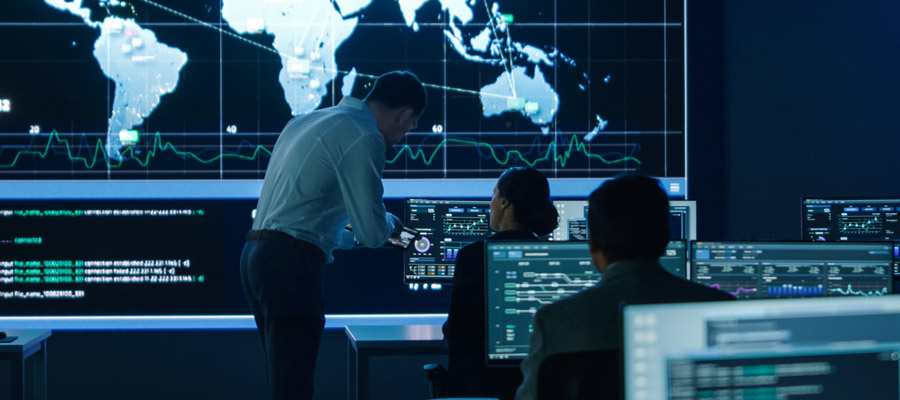
The threat of cybersecurity attacks is higher than ever before. Businesses need to be vigilant against emerging threats. The U.S. government along with several other countries have issued warnings that businesses need to have protective measures in place to help prevent and mitigate cybersecurity attacks.
The security landscape continues to change with new vulnerabilities and malware constantly emerging. It can be difficult for businesses to keep up with the latest threats and keep their infrastructure secure. The team at TPx is here to help businesses strengthen their security posture. Here are seven ways to stay vigilant against cybersecurity attacks today.
Review Security Program Against Industry Standards
A security program should not be created without taking into consideration industry standards as outlined by National Institute of Standards and Technology (NIST) or Cybersecurity & Infrastructure Security Agency (CISA). Both agencies have detailed guidelines of what private and public sector organizations can do to protect themselves against cybersecurity attacks.
Perform Continuous Security Awareness Training
While employees are often a businesses’ greatest asset, they can also be its greatest weakness. According to a study by ICO, 90% of cybersecurity attacks are caused by human error. This is why it’s critical to perform continuous security awareness training for your staff.
Performing training only once or twice a year won’t cut it either. To ensure employees have security best practices top of mind 100% of the time, businesses need to perform security training continuously. Similar to other “healthy habits” security awareness must be done systematically and consistently to see improvements. Through short monthly training content and multiple phishing exercises every other week, users, over time, become more vigilant.
Perform Monthly Vulnerability Assessments
Businesses can’t afford not to have a vulnerability management program in today’s landscape. Conducting monthly vulnerability assessments of the perimeter, can help improve your posture and harden your environment. A vulnerability assessment can identify weaknesses within your infrastructure, as well as identify any new network holes created by system updates and router/firewall changes.
If you’re not sure where to start when it comes to a vulnerability assessment, you can take advantage of security advisory services that will not only identify vulnerabilities but will also provide a roadmap to secure.
Ensure All Systems Patch Level are Current
Patch management is a critical aspect in any cybersecurity program. According to Ponemon Institute, 57% of data breaches are attributed to poor patch management. While many organizations have a patch management program, they are often not current on the latest patches offered by software providers.
Patches are used to update, optimize, and improve security for the software running in your infrastructure. When a provider makes a patch available, the purpose is to improve performance or fix vulnerabilities or issues within the software. If a business isn’t current on all patch levels across the systems they use, they are more vulnerable to cybersecurity attacks.
Enable Multi-Factor Authentication
The password alone isn’t enough to protect your infrastructure from cybersecurity attacks. Even if you require a strong and complex password, phishing and other means to compromise credentials can grant system access to intruders. Another layer of protection is necessary, and multi-factor authentication provides that protection.
Multi-factor authentication is a layered approach to cybersecurity and goes beyond just the password. With multi-factor authentication, businesses can require two or more authentication factors to access a system. These factors include something you are like a fingerprint, something you have like a token or device, and something you know like a password.
By enabling two or more of these authentication factors, businesses can strengthen their security posture and provide more secure login access for their employees. Not only is it more difficult for a cybercriminal to bypass multi-factor authentication, but the user is also notified of the attempted login.
Ensure Endpoints are Using Current Antivirus and EDR
Endpoints should be another integral part in your cybersecurity strategy. Making sure your servers, computers, and other devices are running a Next-Generation Antivirus (NGAV) can help improve your security at the endpoint.
NGAV alone is not enough, at a minimum include additional software protection like endpoint detection and response (EDR). With EDR, your endpoints are monitored 24/7 for threats focusing on the behavior of the malware. If a cybersecurity attack occurs, the system will automatically detect the threat, notify you, and mitigate it. The time it takes for a business to react to a threat can have a direct impact on the severity a cybersecurity attack can have on the business.
Validate Backups are Working Properly and Protected from Ransomware
Most businesses have a backup, but unfortunately, many aren’t backed up or tested regularly to ensure a proper restoration and recovery of your data is possible. If your business is impacted by a ransomware attack today, do you know what you would do? Have you validated that your backups are working properly?
A backup of your data can provide more options when it comes to ransomware attacks. Instead of just paying out the ransom, businesses can isolate infected areas and restore their systems to before the cybersecurity attack occurred. A managed backup solution can help ensure your backups are working properly, so in the event you need them, you won’t have to experience any data loss.
In addition, it is imperative that your backup solution is protected from ransomware or from being compromised in an attack. Make sure the backup system is patched, contains EDR and NGAV, and is monitored closely for anomalous behavior.
Cybersecurity is more important now than ever before. We hope these tips will help your business stay vigilant and make good cyber-secure decisions. The experts at TPx are here to help your business stay secure with a complete suite of Managed Security Services. Interested in learning how we can help? Contact a TPx representative today.
